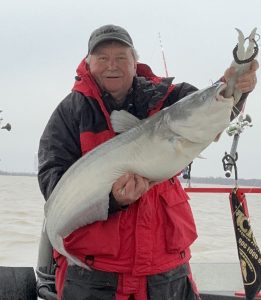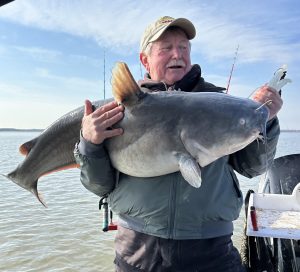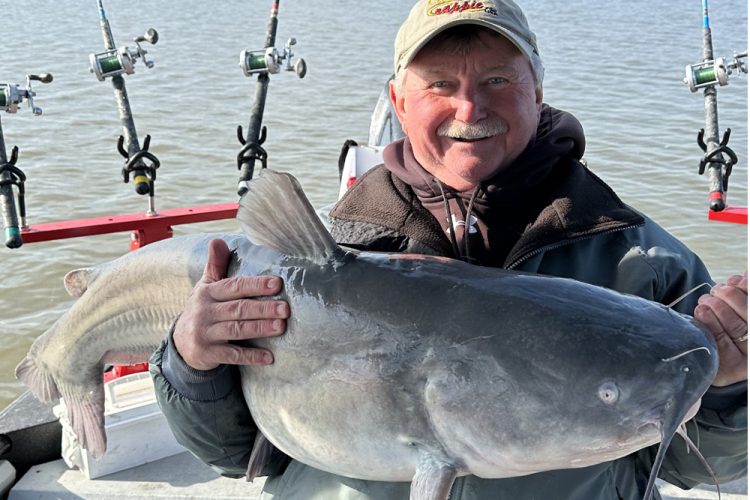Yeah, it’s cold, but the fishing for blue catfish often is hot in the winter,
Mike Baker will tell you. Photos courtesy of Mike Baker
Cold Weather, Hot Fishing For Big Blue Cats
By Brent Frazee
Missouri fisherman finds the best fishing of the year during winter
It takes a lot to keep Mike Baker off the water. “I’ll fish as long as the water is liquid,” the Missouri fisherman said.
Sometimes, even a little ice won’t even keeping him from going catfishing during his favorite time of the year.
He remembers one tournament at Lake of the Ozarks year ago when there was a skim of ice on the upper end of the spacious reservoir. No problem. Baker broke ice for 20 miles before he reached the place he wanted to fish. It was worth it. In the days before there was a slot limit on Lake of the Ozarks and Truman Lake, he caught five blue cats totaling 111 pounds by 8:30 a.m.

“I didn’t catch another fish the rest of the day, but I still won,” Baker said.
That goes a long way in explaining why winter is Baker’s favorite time to chase big blue cats at Missouri’s two giant reservoirs, Lake of the Ozarks and Truman.
When the water temperature drops into the low 50s and many catfish anglers call it quits for the year, Baker shifts into winter mode.
He knows the colder water won’t kill the blue cats’ appetite. Quite the contrary; the chill of late fall and early winter often inspires them to bite.
“Your casual fishermen aren’t going to be out there,” he said. “You have to be willing to pay the price, but the fish will still bite.
“For me, It’s nice to be out there by myself some days. Winter is the best time to fish for big blues, in my opinion.”
Baker bases that opinion on plenty of experience. He doesn’t let the cold of late fall and winter keep him inside. He lives in Columbia, Missouri but has a house near Warsaw, Missouri where Lake of the Ozarks and Truman Lake meet. That’s ideal for someone who likes to chase big catfish. He can go either direction and find productive water.
In recent years, he has been concentrating on Truman, which has an abundant population of blue cats. He likes to fish the reservoir’s upper end, either the Highway 13 area on the Grand arm or the Talley Bend area on the Osage arm.
“On the Grand arm, there are huge, timbered, fairly shallow flats,” he said. “Most of the water will only be eight to 12 feet deep. But there are creek channels running through those flats where the water is a little deeper.
“You wouldn’t expect to find big catfish there, but I’ve caught some 30- to 40-pound fish there.”
Baker starts the day by netting baitfish. Then he cuts them into small chunks, a key for winter catfishing, he said. ” I catch some big catfish on small baits in the winter,” he said.
He looks for a place where the wind is blowing in and ties to flooded trees near a creek channel. Then he experiments by casting some of his lines to the creek channel and others in the surrounding timber.

He uses a B’n’M Bomber catfish rod, which has a light tip and a sturdy backbone. He uses 40-pound-test, high-visibility monofilament as his main line and a leader of 80-pound K9 fluorocarbon.
On good days, it isn’t unusual for him to catch a limit of blue cats (10 daily, with a 26- to 34-inch protected slot length limit and no more than two measuring more than 34 inches).
The fishing at Lake of the Ozarks is decidedly different. There is little standing timber, a testament to its age (it was built in the late 1920s and early 1930s). But it still has a healthy population of blue catfish that relate heavily to the lake’s shad.
On the upper end, that might mean fishing on shallow mud flats, where he anchors when he spots roaming catfish feeding on schools of shad.
“These fish feed in packs sometimes,” he said.
Baker seldom keeps fish. He supports catch and release, especially of the big fish that can be decades old. He is out there for the sport.
Years ago, he was an avid bass angler, fishing as many as three tournaments a week. He even competed on the professional BASS circuit for a few years.
Once he and his wife had a baby, he opted to stay home and raise a family. He later got into crappie fishing and even fished the tournament circuit for a while.
Lately, though, he spends most of his time fishing for big catfish and crappie. He has proof for his fish stories. He runs his GoPro when he fishes and provides instructional videos in his Mike Baker Videos channel on YouTube.
Viewers have watched Baker tangle with big blue cats in the cold-weather months as he reveals his strategy for catching them.
He modestly says, “I’m not the best catfisherman out there. There are a lot of people who know more about it than me. But I’m learning.”
(Brent Frazee is an award-winning writer and photographer from Kansas City, Mo. He served as outdoors editor of The Kansas City Star for 36 years before retiring in 2016. He continues to freelance for magazines, websites and newspapers.)



